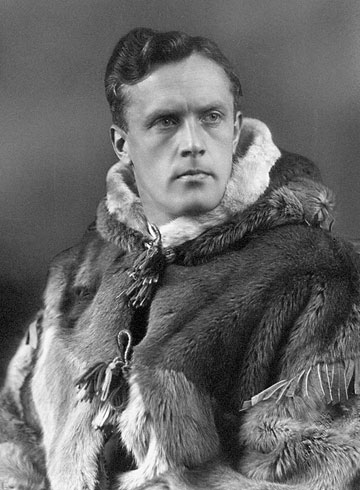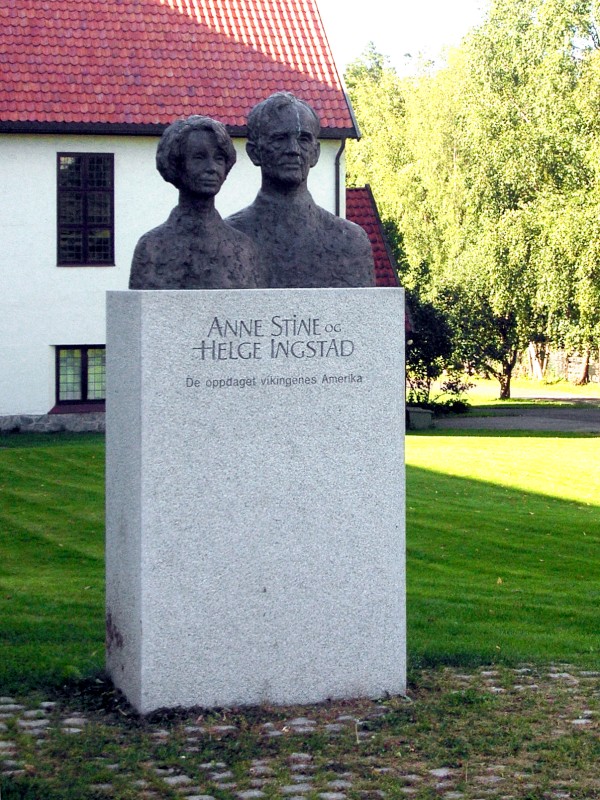<Back to Index>
- Explorer Helge Marcus Ingstad, 1899
- Author Rudyard Kipling, 1865
- Prime Minister of Japan Hideki Tōjō, 1884
PAGE SPONSOR


Helge Marcus Ingstad (30 December 1899 – 29 March 2001) was a Norwegian explorer. After mapping some Norse settlements, Ingstad and his wife Anne Stine, an archaeologist, in 1960 found remnants of a Viking settlement in L'Anse aux Meadows in the Province of Newfoundland in Canada. With that they were the first to prove conclusively that the Greenlandic Norsemen had found a way across the Atlantic Ocean to North America, roughly 500 years before Christopher Columbus and John Cabot. He also thought that the mysterious disappearance of the Greenland Viking settlement in the 14/15th century could be explained by their emigration to North America.
Helge Ingstad was born to Olav Ingstad and Olga Marie Qvam. His father was municipal engineer in Tromsø and held the title of factory supervisor. Helge grew up in Bergen, and after graduating cand. jur. in 1922 he took up a practice of lawyer in Levanger.
Helge Ingstad was originally a lawyer by profession, but, ever an outdoorsman, he sold his successful law practice in Levanger and went to Canada's Northwest Territories as a trapper in 1926. For the next three years, the Norwegian travelled with the local Indian tribe known as the Caribou Eaters. After returning to Norway, he wrote the bestselling Pelsjegerliv ("Trapper Life") about his time in Canada, published in English as The Land of Feast and Famine.
Ingstad was the governor (Sysselmann) of Erik the Red's Land in 1932–33, when Norway annexed that eastern part of Greenland. The Permanent Court of International Justice in The Hague decided that the lands belonged to Denmark,
and so the official Norwegian presence had to end. Following the
verdict, Ingstad was summoned by the government to the job as governor
of Svalbard (Spitsbergen
and the surrounding islands) — a position suiting him uniquely,
considering his profession of law and his experience in Arctic living.
During his years on Svalbard Helge Ingstad met his wife, Anne Stine,
nearly twenty years his junior. She had read his books from Canada and
Greenland with great admiration, and got a crush on the explorer; she
wrote to him, and after some time of correspondence and dating they
were engaged and married. In 1946 the Ingstads made themselves a home
near the Holmenkollen area of Norway's capital, Oslo,
where they spent the rest of their lives when not travelling the world.
They had one daughter, Benedicte, who became an archaeologist like her
mother. From her teenage years, Benedicte accompanied her parents on
their exploration journeys. Helge
Ingstad was a popular author, whose books on his visits to remote parts
of the world gained him fame in Norway. From Greenland he wrote Øst for den store bre ("East of the Great Glacier"), from Svalbard he wrote Landet med de kalde kyster ("The Land With the Chilly Coasts"). He also visited the Apache Indians of northwestern Mexico, from which he wrote Apache-indianerne - jakten på den tapte stamme ("The Apaches - The Hunt for the Lost Tribe"). After World War II he stayed for a period in the Brooks Range in northern Alaska among the Nunamiut eskimo tribe, and afterwards wrote Nunamiut - blant Alaskas innlandseskimoer ("Nunamiut - Inland Eskimos of Alaska"). Helge Ingstad has two geographic features in North America named after him. In Canada, a small river, Ingstad Creek, flows into Great Slave Lake. In Alaska, the 1461-meter-high Ingstad Mountain in the Brooks Range was officially approved by the U.S. Board on Geographic Names on 19 April 2006. The name was suggested by the Nunamiut tribe in gratitude for Ingstad's efforts on their behalf. The asteroid 8993 Ingstad is also named after him. Helge Ingstad died at Diakonhjemmet's hospital in Oslo at the age of 101. During the last few years of his life, he worked on categorizing and annotating the large quantity of photos and audio recordings (141 songs) he had made while living with the Nunamiut in 1950. The effort resulted in a booklet, Songs of the Nunamiut, with an accompanying CD containing the audio material. This is an extremely valuable contribution to the preservation of the Nunamiut culture,
because it turned out that much of what he had gathered in the mid-20th
century was now lost locally and was only preserved in his recordings.
He was honorary member of the Norwegian Academy of Science and Letters. He also held honorary doctorates at the University of Oslo, Memorial University of Newfoundland in Canada, and at St. Olaf College in Minnesota. He was awarded the meritorial Royal Norwegian Order of St. Olav, Knight of the Order of Vasa, and he was presented with the Red Cross sign of honor for his efforts in Finnmark during World War II. He received a lifetime government grant from the Norwegian government from 1970. In 1986 he was presented Arts Council Norway's honor award.